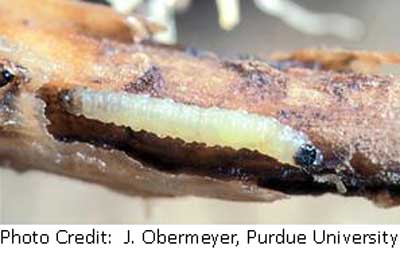
- Corn rootworms (CRW) are one of the most important insect pests of corn in the Midwest with the potential to cause significant yield losses and increase lodging.
- As of June 18, 2018, peak egg hatch has occurred in most of the Midwest and first, second or third instar larvae may be found feeding on corn roots.
- Scouting should start about two weeks after peak hatch but can also be done later in the season to evaluate root damage
- Even though low CRW populations have been observed in recent years, scouting is key to prevent, correct and predict the potential for CRW damage
Corn rootworms (CRW) are one of the most important insect pests of corn in the Midwest with the potential to cause significant yield losses and increase lodging. A compilation of field research trials suggests that around 15% yield reduction can occur for each nodal root consumed by CRW larvae. Female CRW beetles lay eggs in the soil in late summer and those eggs overwinter to resume development the following spring. CRW development is driven by soil temperatures and it’s measured in degree days. Fifty percent CRW egg hatch occurs between 684 and 767 accumulated degree days (52°F base soil temperature). As of June 18, 2018, peak egg hatch has occurred in most of the Midwest and first, second or third instar larvae may be found feeding on corn roots.
Scouting should start about two weeks after peak hatch but can also be done later in the season to evaluate root damage. Scouting early will provide more time to make rescue management decisions if necessary. To evaluate the number of larvae present, carefully dig and remove a 7” x 7” cube of soil around the base of one plant in at least ten locations of the field. Place and crumble the soil over a dark background and examine for CRW larvae. Alternatively you can immerse the sample in a bucket of water and if CRW larvae are present, they will float to the surface. If an average of two or more larvae are found per plant using the soil crumbling method or eight or more are found using the float method a control may warrant. Evaluate root injury around mid-late July to determine the severity of root damage. Dig one plant in each of ten randomly selected areas and wash the roots to remove the soil. Using the Iowa State node injury scale, rate the roots from 0-3 where 0 = no damage and 3 = three or more nodes have been eaten.
Where to sample first? High risk fields should be sampled first. These include:
- Fields planted with hybrids without CRW Bt traits
- Fields with a history of CRW Bt trait failures
- Fields on continuous corn
- Fields with high CRW beetle counts the previous year
Corn rootworm resistance to Bt traits was first documented in 2009 and cross-resistance was confirmed a couple of years later. Scouting provides information on the performance of CRW Bt traits and can help diagnose resistance build up in a field. Regarding CRW adult counts, they can help predict the potential for CRW larval damage the following season. In 2017 a Monsanto survey conducted across 13 corn growing states found that 39% of continuous corn fields exceeded the economic threshold of 2 CRW beetles/ trap/ day. Although CRW populations remained low in many areas in 2017, when overlaying 2017 and 2016 CRW adult counts, a few hot spot trends were identified. These included areas in east central IL, northwest, central and northeast IA, east NE and southeast SD. Even though low CRW populations have been observed in recent years, scouting is key to prevent, correct and predict the potential for CRW damage. Keeping field records across years will help evaluate the performance of our current CRW management program and to make adjustments to our CRW control strategies.
(Published in the Iowa Spokesman June 2018)